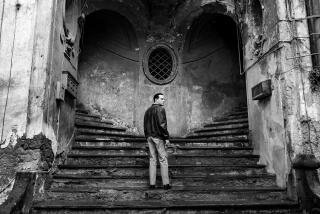John Beckman; Designed Sets for ‘Casablanca,’ TV
John Beckman, filmdom’s legendary art director and set designer, who in an era and industry focused on the abilities of youth continued to enjoy a career into his 91st year, died Wednesday in his sleep at his Sherman Oaks home.
He celebrated his birthday March 27 and in an accompanying interview talked of the 14- and 15-hour workdays he still enjoyed as art director of CBS’ popular TV series “Designing Women.”
Over the years, Beckman, whose film work began in 1934 as art director of “Nana,” amassed an array of credits that extended from the interior of Grauman’s Chinese Theater to the murals and theater of Santa Catalina Island’s Avalon casino to the sets of “Casablanca,” “Lost Horizon” and “The Maltese Falcon.”
Born in Oregon, he was raised in San Francisco and remembered well the fires that followed the 1906 earthquake. His parents sent him to Russia to study architecture, but he was 12 and had to wait two years to qualify for entry to the architectural academy at St. Petersburg.
Beckman was forced to return to the United States in 1912 when his mother became ill. (He had booked passage out of England on the Titanic but, at the urging of friends who told him the new luxury liner was unsafe, changed to its sister ship the Olympic.)
Beckman attended UC Berkeley briefly (he said he was expelled for asking “too many embarrassing questions”) and then hired out to a Sacramento architect before moving to Los Angeles in 1920.
“This was a small town of maybe 400,000,” he recalled last March. “You could smell orange and lemon blossoms everywhere.”
He went to work for the firm that designed the Grauman’s Egyptian and Chinese theaters, where Beckman created color schemes, furnishings, wall hangings and murals.
He segued into films through friends and, after “Nana,” designed sets for “House of Rothschild,” “One Night of Love,” “Follies Bergere,” “A Midsummer Night’s Dream” and, in 1950, “The Glass Menagerie.”
He was art director for Charlie Chaplin’s “Monsieur Verdoux,” as well as “The Bad Seed,” “Gypsy” and “The Devil at 4 O’Clock.”
In 1929, he directed the work of five artists who painted the giant and elaborate murals of underwater scenes at the Avalon casino. The murals were restored as part of a casino renovation in 1987.
For the past two decades, Beckman had been concentrating on television, which he described as “very sudden; I find I’m trying to beat the clock.”
Pilot films and series he designed for include “Mr. Deeds Goes to Town,” “The Partridge Family,” “Nero Wolf,” “Cheers” and “Webster.” And his last, “Designing Women.”
Asked the perennial question about the secret of his strength and longevity, he said on his last birthday that he wasn’t really sure.
“I smoked for 35 years and I eat a lot of sugar. So it could be my attitude. I don’t let anything bother me.”
A widower, Beckman is survived by a son, daughter and two granddaughters.
More to Read
Only good movies
Get the Indie Focus newsletter, Mark Olsen's weekly guide to the world of cinema.
You may occasionally receive promotional content from the Los Angeles Times.










